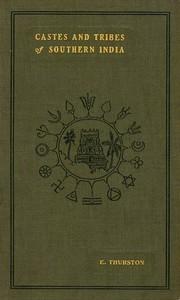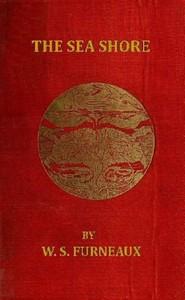|
|
Read this ebook for free! No credit card needed, absolutely nothing to pay.Words: 31026 in 11 pages
This is an ebook sharing website. You can read the uploaded ebooks for free here. No credit cards needed, nothing to pay. If you want to own a digital copy of the ebook, or want to read offline with your favorite ebook-reader, then you can choose to buy and download the ebook.

: Castes and Tribes of Southern India. Vol. 2 of 7 by Thurston Edgar Rangachari K Contributor - Caste India South; Tribes India South; Ethnology India South; India South Social life and customs@FreeBooksWed 07 Jun, 2023 ached to it. The mother-in-law of the bridegroom now stands ready at the gate, and, on his arrival, places a garland of flowers round his neck. The new cloths are then presented by the Vatti and his wife to the bridegroom and bride respectively, after some tender cocoanut leaves, emblematic of the established occupation of the caste, are thrust into the bridegroom's waist by the headman of the village. In former days, a sword took the place of these leaves. The minnu is then tied round the neck of the bride, and all parties, including the parent or guardian, give presents to the bridegroom. The day's ceremony is then over, and the bridegroom remains at the house of the bride. The string is removed from the bride's wrist by the Vatti on the fourth day, and the couple bathe. More than one girl may have the tali tied at the same time, provided that there are separate bridegrooms for them. Only boys from the families of Machchampis can become tali-tiers. The sambandham of North and Central Travancore differs from that of South Travancore in some material respects. In the former, on the appointed day, the bridegroom, who is a different person from the tali-tier, accompanied by his relations and friends, arrives at the bride's house, and the guardian of the former offers a sum of money to the guardian of the latter. A suit of clothes, with ten chuckrams or ten rasis , is presented by the bridegroom to the bride, who stands in a room within and receives it, being afterwards dressed by his sister. The money goes by right to her mother, and is known as Ammayippanam. Now comes the time for the departure of the bride to her husband's house, when she receives from her guardian a nut-cracker, lime-can, a dish filled with rice, and a mat. A red cloth is thrown over her head, and a few members accompany the party for some distance. In South Travancore, the bridegroom is accompanied, besides others, by a companion, who asks in the midst of the assembly whether they assent to the proposed alliance, and, on their favourable reply, hands over a sum of money as an offering to the local shrine. Another sum is given for the maintenance of the bride, and, in the presence of the guardian, a suit of clothes is given to her by the bridegroom. The wife is, as elsewhere, immediately taken to the husband's house. This is called Kudivaippu, and corresponds to the Grahapravesam celebrated by Brahmans. The following account of marriage among the Izhavas of Malabar is given in the Gazetteer of that district. "A girl may be married before puberty, but the consummation is not supposed to be effected till after puberty, though the girl may live with her husband at once. If the marriage is performed before puberty, the ceremony is apparently combined with the tali-kettu kalyanam. The bride is fetched from the devapura or family chapel with a silk veil over her head, and holding a betel leaf in her right hand in front of her face. She stands in the pandal on a plank, on which there is some rice. On her right stand four enangans of the bridegroom, and on her left four of her own. The elder of the bridegroom's enangans hands one of the bride's enangans a bundle containing the tali, a mundu and pava , some rice, betel leaves, and a coin called meymelkanam, which should be of gold and worth at least one rupee. All these are provided by the bridegroom. He next hands the tali to the bridegroom's sister, who ties it. After this, all the enangans scatter rice and flowers over the bride. In this caste, the claim of a man to the hand of his paternal aunt's daughter is recognised in the ceremony called padikkal tada , which consists of a formal obstruction offered by eleven neighbours to the bride's removal, when she is not so related to her husband They are bought off by a fee of two fanams, and a packet of betel leaf. The girl is then taken to the bridegroom's house. If very young, she is chaperoned by a female relative. On the fourth day there is a feast at the bridegroom's house called nalam kalyanam and this concludes the ceremonies. Marriage after puberty is called Pudamari. The ceremonial is the same, but there is no padikkal tada." When an Izhava girl reaches puberty, the occasion is one for a four days' religious ceremonial. On the first day, the Vatti priestess anoints the girl with oil, and after a bath, dresses her in the cloth supplied by the Mannatti . She is then laid on a broad wooden plank, and is supposed not to go out until she bathes on the fourth day. All the female relations of the family present her with sweetmeats. On the seventh day, she is again taken to and from the village tank with much ?clat, and, on her return, she either treads on cloths spread on the floor, or is carried by an elderly woman. After this, she husks a quantity of paddy, and cooks the rice obtained thence. If this ceremony takes place at the house of a headman, the villagers present him with a vessel full of sugared rice. A two days' ceremonial, called Pulikudi in north Travancore, and Vayattu Pongala in the south, which corresponds to the Pumsavana of Brahmans, is observed at the seventh month of pregnancy. On the first day, at twilight in the evening, the pregnant woman, preceded by the priestess, proceeds to the foot of a tamarind tree on the southern side of the compound. Arriving there, she receives a thread seven yards in length, to which a silver ring is attached at one end, and, by means of circumambulation, entwines the tree with the thread. If the thread is by chance or inadvertence broken during this process, the popular belief is that either the mother or the child will die soon. Next day, the thread is unwound from the tree, and a handful of tamarind leaves is given to the woman by her husband. On re-entering the house, tamarind juice is poured through the hands of the husband into those of the wife, who drinks it. The priestess then pours a quantity of oil on the navel of the woman from a betel leaf, and, from the manner in which it flows down, it is believed that she is able to determine the sex of the unborn child. The woman has to lean against a cutting of an ambazham tree while she is drinking the juice, and this cutting has to be planted in some part of the compound. If it does not grow properly, the adversity of the progeny is considered to be sealed. The husband is given a ring and other presents on this occasion. Women bathe on the third, fifth, and nineteenth day after delivery, and wear the mattu or changed cloth of the Mannatti, in order to be freed from pollution. The name-giving ceremony of the child takes place on the twenty-eighth day. It is decorated with a pair of iron anklets, and a ribbon passed through a few pieces of iron is tied round its waist. It is then held standing on a vessel filled with rice, and, its left ear being closed, a name is muttered by its guardian into the right ear. The first feeding ceremony is observed in the sixth month, when the iron ornaments are removed, and replaced by silver and gold ones. The ear-boring ceremony takes place at an auspicious hour on some day before the child attains its seventh year. In former times, only the eldest male member of a family was cremated, but no such restriction obtains at the present day. When a member of the community dies, three handfuls of rice are placed in the mouth of the corpse by the eldest heir after a bath, followed by the sons, nephews, and grandsons of the deceased. Every relative throws an unbleached cloth over the corpse, after which it is taken to the burning-ground, where the pyre is lighted by the heir with a consecrated torch handed to him by the priest. A wooden plank is furnished by the carpenter, and an impression of the foot of the deceased smeared with sandal paste is made on it. The name, and date of the death of the deceased, are inscribed thereon, and it has to be carefully preserved in the house of the heir. The record refreshes his memory on occasions of sradh , etc. When the cremation is half completed, the contents of a tender cocoanut are placed beside the head of the corpse as an offering, and prayers are muttered. A pot full of water is then borne by the chief mourner on his shoulder thrice round the corpse. As he does so, the priest pricks the pot thrice with an iron instrument. Finally, the pot is broken on the pyre, and the chief mourner returns home without turning back and looking at the corpse. On the second day, an oblation of food is offered to the departed. The inmates of the house are fed with conji on this day by the relatives. The Sanchayana, or collection of bones, takes place on the fifth day. Pollution lasts for fifteen days in Central and North Travancore, but only for ten days in the south. There are some rites, not observed necessarily by all members of the caste, on the forty-first day, and at the end of the first year. Persons who have died of contagious diseases, women who die after conception or on delivery, and children under five years of age, are buried. Pollution is observed only for nine days when children die; and, in the case of men who die of contagious disease, a special group of ceremonies is performed by the sorcerer. Those who are under pollution, besides being forbidden to enter shrines and other sanctuaries, may not read or write, or partake of liquor, butter, milk, ghi, dhal, or jaggery. Jada.--Jada or Jandra, meaning great men, has been recorded as a synonym of Devanga and Kurni. Jaggali.--The Jaggalis are defined, in the Manual of the Ganjam district, as Uriya workers in leather in Ganjam. It is recorded, in the Madras Census Report, 1901, that "the traditional occupation of this caste was apparently leatherworking, but now it is engaged in cultivation and miscellaneous labour. Its members speak both Oriya and Telugu. They admit outcastes from other communities to their ranks on payment of a small fee. Marriage is either infant or adult, and widows and divorc?es may remarry. Satanis are employed as priests. They eat beef and pork, and drink alcohol. They bury their dead. In some places they work as syces , and in others as firewood-sellers and as labourers. Patro and Behara are their titles." It may, I think, be accepted that the Jaggalis are Telugu Madigas, who have settled in Ganjam, and learnt the Oriya language. It is suggested that the name is derived from the Oriya jagiba, watching, as some are village crop-watchers. Jaikonda .--A sept of Domb. Jain.--"Few," Mr. T. A. Gopinatha Rao writes, "even among educated persons, are aware of the existence of Jainas and Jaina centres in Southern India. The Madras Presidency discloses vestiges of Jaina dominion almost everywhere, and on many a roadside a stone Tirthankara, standing or sitting cross-legged, is a common enough sight. The present day interpretations of these images are the same all over the Presidency. If the images are two, one represents a debtor and the other a creditor, both having met on the road, and waiting to get their accounts settled and cleared. If it is only one image, it represents a debtor paying penalty for not having squared up his accounts with his creditor." It is recorded, in the Madras Census Report, 1891, that "out of a total of 25,716 Jains, as many as 22,273 have returned both caste and sub-division as Jain. The remainder have returned 22 sub-divisions, of which some, such as Digambara and Swetambara, are sectarian rather than caste divisions, but others like Marvadi, Osval, Vellalan, etc., are distinct castes. And the returns also show that some Jains have returned well-known castes as their main castes, for we have Jain Brahmans, Kshatriyas, Gaudas, Vellalas, etc. The Jain Bants, however, have all returned Jain as their main caste." At the Madras census, 1901, 27,431 Jains were returned. Though they are found in nearly every district of the Madras Presidency, they occur in the largest number in the following:-- South Canara 9,582 North Arcot 8,128 South Arcot 5,896 Free books android app tbrJar TBR JAR Read Free books online gutenberg More posts by @FreeBooks
: The Sea Shore by Furneaux William S Lillie R Illustrator - Seashore biology; Seashore; Marine biology Great Britain@FreeBooksWed 07 Jun, 2023

: A Selection of Books Published by Methuen & Co. September 1913 by Methuen Co - Publishers' catalogs England; Methuen & Co. Catalogs@FreeBooksWed 07 Jun, 2023
|
Terms of Use Stock Market News! © gutenberg.org.in2025 All Rights reserved.






